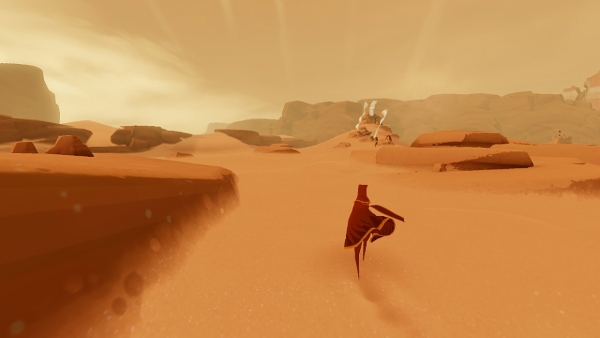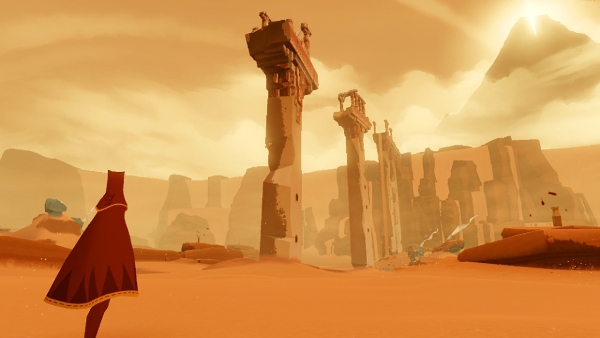
Thatgamecompany’s latest creation, Journey, is more like a work of art than a video game. In fact, I’d go so far as to venture that this game is going to revive the whole “video games as art” argument all over again. Journey brings to life the story of a lone traveler, trekking across the desert to the source of a fallen star at the apex of a mountain. The trip is a spiritual one, something of a pilgrimage, and the symbiotic relationship the main character has with the fabric creatures creates a unique experience that is startlingly emotional for such a short game.
Platforms: PS3
Publisher: Sony Computer Entertainment
Developer: Thatgamecompany
Genre: Artistic Adventure
Release Date: March 6, 2012
ESRB Rating: Everyone
 Journey’s main character is an androgynous figure in a brown cloak. I’ll refer to the character as a “she” simply because that’s what it strikes me as – something about her nimble, emotive movements just makes it feel that way. You begin at the top of a sand dune, which has a few graves at the top. Your first movements are through a graveyard in the desert to the top of a building, where you touch your first glyph and begin to create a scarf around your neck.
Journey’s main character is an androgynous figure in a brown cloak. I’ll refer to the character as a “she” simply because that’s what it strikes me as – something about her nimble, emotive movements just makes it feel that way. You begin at the top of a sand dune, which has a few graves at the top. Your first movements are through a graveyard in the desert to the top of a building, where you touch your first glyph and begin to create a scarf around your neck.
Here is where the relationship with the fabric creatures begins. The glyph itself is surrounded by what look to be smaller, floating pieces of a scarf. Holding the Circle button calls them to you, filling your scarf with energy, which is indicated by glyphs covering it. If you hold the button down, the fabric pieces launch you into the air, and if your scarf is full, you can fly with the X button. Flying expends the glyphs, leaving your scarf blank again.
These glyphs that you find are not the same as the symbol that is emitted when you use the Circle button to call the creatures to you. This symbol is your own unique one, which appears when you speak. That same symbol also appears on your chest when you call out, lighting up in time with your call. Tapping the Circle button makes a sound and brings the symbol up for a moment.
The beautiful fabric creatures fly through the air in little schools, and when you call them to you, they pause for a moment, then swirl around you, bathing everything in light. Finding more glyphs helps to extend your scarf further, and the fabrics fill your scarf up whenever you call to them. Extending the scarf allows you to fly for longer periods of time.

Each level has its own puzzles, glyphs, fabric creatures, and scenes revealing more aspects of the story and the history of the character’s race, which seems to have gone to war with another race – that of giant flying monsters. As you finish each level, more of the story is revealed in cut scenes, which are hieroglyphics that tell more of the story, showing you what the next level will have in store for you.
These are all of the basic characteristics of the game, but the truth is that no words could describe just how touching and beautiful this game is. It’s more than just the feeling of the sand as you trudge up a dune, or the weightlessness of flying. The swirling of the fabric creatures around you is full of affection. But one of the most interesting aspects of the game is the multiplayer.
During your travels, you will meet other players who are also on their own journey. This is the unique multiplayer mode of Journey, in which other players also connected to the PlayStation Network can join in your quest. The two of you can recharge one another’s scarves, and you can also speak to each other with your unique symbols. The first time I met someone else, I ran around them, tapping Circle, my scarf wrapping around them. They, too, ran around in circles, calling to me as well. After my long, lonely journey in the hot desert, finding another person was like an oasis of companionship.

Some of the Trophies can only be obtained with another player. I watched as my boyfriend played, and another player came into his game, talking to him and running around him. The other character lead him to a spot where he could help him get another Trophy, and they worked together to make it there. At the end of it, my boyfriend ran around him, tapping Circle. I felt my heart fill up, watching as this stranger helped another stranger. It was a lovely feeling, seeing a game in which the multiplayer aspect was all beneficial with no malicious intents.
As for the graphics, this game is top notch. The way the sun hits the sand as you’re riding a dune, the imposing bulk of the enemy creatures as they try to hunt you down, the ancient buildings being eroded by sand, wind, and time: everything is crisp and beautiful. The effects are incredible as well – the color of the sky and placement of the clouds, the sand that gets blown around by the wind, the sandfalls that flow like waterfalls to the floor of the desert. But the most beautiful visual part of the game is the character design of both the main character and the fabric creatures, of which there are different kinds as you progress. The simplicity of the main character does not prevent her from being elegant and poignant in the least.
While the visuals in the game are exquisite, the score is definitely a huge part of what makes this game successful. It ranges from moody, to dangerous, to uplifting. The sound effects are also perfect, punctuating interactions with creatures and other characters in a way that makes you feel like you are having conversations with them.
Everything about Journey is perfect. As a gaming experience, it’s very short, but has a lot of potential for replayability. It’s more than just a stunning game – it’s a work of art. From the acute loneliness of the main character, to the spiritual undertones of the background story, to the delightful interactions with the fabric creatures, there’s so much emotion in a tiny package. Animation studios and movie directors alike could find a lot to learn from Journey. At $14.99, this game is a steal.

Review Disclosure: A retail copy of Journey was purchased by Warp Zoned for the purposes of this review.







